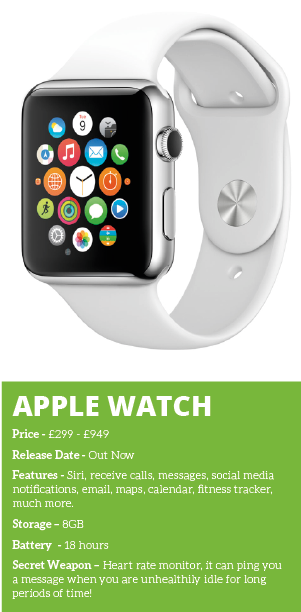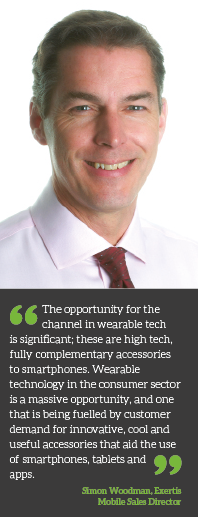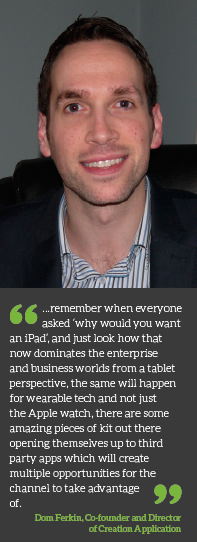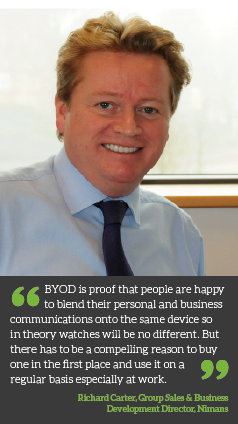
When it comes to wearables and the potential opportunity for Channel partners to get involved there is definitely a difference in opinion out in the market place. The predictions coming from the analysts are solid as consumers start to build their appetite for the technology, in the B2B market the opportunities remain unclear. David Dungay investigates.
Vertical Sectors

Most of the use cases I see for the wearable market seem to be coming out of the healthcare market right now, and distributor Exertis seem to be making more noise than most in this space. They have signed up several vendors and more recently announced their agreement with iHealth to distribute blood pressure monitors, wireless scales, fitness devices and glucometers. Exertis are adamant there are significant opportunities within the education and hospitality sectors also.
Joe Officer, Head of Accessories for Exertis, commented “Health services globally are struggling with the burden of growing/aging populations and continue to put more emphasis onto patients directly to monitor their own well-being. And more generally, consumers themselves want to use their increasing number of connected devices to proactively stay in tune with their bodies. The potential for iHealth in the UK is vast.”
Simon Woodman, Exertis Mobile Sales Director added “Wearable technology is still in its infancy, but it is already showing signs of being a child prodigy. From beginnings in the mobile app world with health and fitness trackers, to accessories such as smartbands that bought those apps to life, to smartwatches, smart prosthetic limbs and even smart lenses that will be able to diagnose and monitor diseases, this sector has come a long way in a very short space of time.
Not everyone is convinced when it comes to the potential in the Channel. Richard Carter, Group Sales & Business Development Director at Nimans stated “I think potential is the operative word. There’s currently little appetite for wearables on a consumer level let alone the business community. There’s little evidence things will change anytime soon but there’s a lot of hope that the Apple Watch is going to be a major turning point. For me the jury is out on wearables and I think sales reflect this. No one is really buying them and I don’t see people wearing them. I’ve heard that many are being discounted as part of a smartphone bundle package so there’s a lot of work and convincing to be done to change a very sceptical marketplace.”
Woodman disagrees, he says “Some people are questioning the longevity of the wearables market, and some are already calling it a failure, but this market is exhibiting signs of being one of the most dynamic, fast-evolving tech categories we at Exertis have ever seen. It is evolving rapidly, across all sectors, from wearables that are designed to be basic accessories to smartphones, to the truly cutting edge.”
Business Apps
Dom Ferkin, Co-founder and Director at app developer Creation Application says “The Apple watch can serve a purpose for many other sectors, which Channel partners may have as customers. As an example we are working on a retail solution which uses iBeacon technology and our client wants the iBeacon notifications to appear on the Apple watch, so I can definitely see demand increasing for the right type of applications, allowing the channel to re-sell to their client base and take the margin.”
 He continued “Wearable tech is a very exciting area to be in, and I personally think it’s more than a flash in the pan. As these devices become more advanced, they won’t be phone ‘companions’ but stand alone devices, which presents a much larger opportunity. Tech is advancing every day, and wearables is no different, remember when everyone asked ‘why would you want an iPad’, and just look how that now dominates the enterprise and business worlds from a tablet perspective, the same will happen for wearable tech and not just the Apple watch, there are some amazing pieces of kit out there opening themselves up to third party apps which will create multiple opportunities for the channel to take advantage of.”
He continued “Wearable tech is a very exciting area to be in, and I personally think it’s more than a flash in the pan. As these devices become more advanced, they won’t be phone ‘companions’ but stand alone devices, which presents a much larger opportunity. Tech is advancing every day, and wearables is no different, remember when everyone asked ‘why would you want an iPad’, and just look how that now dominates the enterprise and business worlds from a tablet perspective, the same will happen for wearable tech and not just the Apple watch, there are some amazing pieces of kit out there opening themselves up to third party apps which will create multiple opportunities for the channel to take advantage of.”
WYOD
As with the BYOD revolution which saw the Channel create solutions to manage personal devices in the workplace some experts are predicting a similar trend with werables (Wear Your Own Device). Networks in the workplace are often under pressure with the influx of smartphones and the sheer amount of data they transmit, wearables will likely exacerbate this problem. The same issues such as security and data sovereignty are likely to rear their heads too.
Carter shared is thoughts, “BYOD is proof that people are happy to blend their personal and business communications onto the same device so in theory watches will be no different. But there has to be a compelling reason to buy one in the first place and use it on a regular basis especially at work. “

Carter continued “Wearables undoubtedly have a place in the market but at what level remains to be seen. There’s a lot of hope that the sector will start to take off, but when or even if, remains to be seen. Wearables will undoubtedly get going but it needs a whole new set of apps to be developed to make it an advantage to have something on your wrist. One obvious area is contactless payment. Wearables will get going as the apps improve. If anyone can get smart watches to sell it is Apple.
“There’s an app to send your heartbeat to someone else which to me is just a bit of a gimmick. I think there’s been some limited demand in the health and fitness sector. The phone remains king for now and I don’t see it changing soon. For resellers it’s an area they should be aware of and monitoring. Maybe in 12 months things will become a lot clearer as the business sector begins to gain some traction.”
Woodman firmly believes the opportunity is here and now. He said “Exertis recognised the potential of the wearable technology market at the beginning of 2013, and in 2014 we added significantly to our successful stable of existing products from key manufacturers Jawbone, Samsung, Sony Mobile and LG. Now, we lead the distribution field in wearable technology with significant shipments to our channel partners.”
Woodman concluded “The future for wearable technology is set to be great. End user demand is driving manufacturers to get involved. We are now entering the battle of the operating systems, as Android, iOS and Windows Phone push to become leaders in this innovative category. These are truly interesting times for this technology and for the channel. Wearable technology is here to stay, and it is going to make the lives of millions of people around the world better.”
What the Analysts say...
Sales of wearables will grow from 29 million in 2014 to 172 million in 2018, with a spike in 2015. The most popular devices will be smartwatches and fitness trackers. This is according to CCS Insight’s latest global wearables forecast.
The next 12 months will be a transformative year for the wearables market thanks to the arrival of the Apple Watch. This highly anticipated smartwatch will create a frenzy of demand, catapulting it almost instantaneously to be the most successful smartwatch ever. CCS Insight expects Apple to employ its full marketing arsenal and the power of its brand to create another must-have status symbol.
 CCS Insight projects Apple will account for a quarter of the wearables market in 2015, selling around 20 million Apple Watches by the end of the year. This is equivalent to about 7% of those who own a compatible iPhone at the time of the product’s launch. The current love affair affluent US consumers have with the iPhone guarantees a strong start for the Apple Watch in its home market. However, if sales of the Apple Watch fail to meet expectations it could hurt the whole smartwatch market.
CCS Insight projects Apple will account for a quarter of the wearables market in 2015, selling around 20 million Apple Watches by the end of the year. This is equivalent to about 7% of those who own a compatible iPhone at the time of the product’s launch. The current love affair affluent US consumers have with the iPhone guarantees a strong start for the Apple Watch in its home market. However, if sales of the Apple Watch fail to meet expectations it could hurt the whole smartwatch market.
While the Apple Watch will be in the spotlight this year, fitness bands from companies such as Fitbit and Jawbone will continue to dominate the wearables market, building on their explosive growth in 2014. CCS Insight analyst George Jijiashvili observes, “We expect sales of fitness and activity devices to double in 2015 to 40 million units. In contrast to many other commentators, we don’t believe smartwatches will dent sales of fitness products in the short term. Smart fitness devices do one thing and do it well: they measure activity with the goal of improving owners’ well-being. This, combined with lower retail prices, longer battery life and a strong head start in terms of adoption, suggests that these devices will outperform smartwatches for several years to come.”
Dr Jan Wassmann, Global Product Manager for Wearables at GfK, comments, “Many consumers are not yet aware of the additional benefits a smartwatch has to offer. We believe this will now change, driven by the marketing efforts of the industry this year. Added to this, there is a clear convergence of both segments, which started in the second half of 2014 – and we see this driving market growth. HFT manufacturers are introducing new models which incorporate smart functions, such as reading notifications and messages. And many new smartwatches now come with heart rate sensors and activity tracking capabilities and are being marketed as hybrid fitness devices.”
Ed Says…
As with every new market there is a risk of poor performance or inferior first edition devices creating a bad name for the wearable market. The Apple Watch will undoubtedly have a big impact on the market as a whole but there is still a question mark over the Channel opportunity. Dom Ferkin thinks the value lays in the third party app space rather than the kit itself, coupled with the potential to manage devices from the newly coined WYOD trend I tend to agree.
